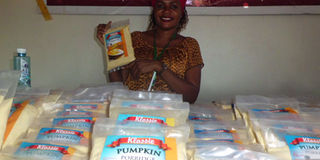Pumpkin processing made easy

The farmer explains how to make the porriadge. PHOTO by francis mugerwa
What you need to know:
- Moses Ddiba a vegetable agronomist and agro-processing agricultural officer in Bulindi, Hoima District, says farmers should be encouraged to add value to produce for more cash, writes Lominda Afedraru.
Joyce Kyalema is a youth processing pumpkin into flour packages and markets it to make a living.
As I approach Makerere University stalls at the 2018 agriculture trade show in Jinja, Kyalema’s stall has attracted a lot of show goers who are busy testing porridge which she has prepared using pumpkin flour.
The young lady is so enthusiastic in handling everyone who comes to her stall. She quickly attends to me as I engage her in interview about as to how she adds value to pumpkin.
Beginning
“It is now approximately four years that I have been involved in this initiative. I started this after completing my studies in Business Administration at Makerere University Business School in 2014 where I vigorously engaged in sensitising rural women in Mubende, Masaka and Mityana districts about the importance of growing Pumpkins,” says Kyalema.
During the sensitisation exercise she told farmers that those who venture into pumpkin growing get returns within days of planting.
As soon as the crop starts to trail, a farmer starts earning from the leaves, he/she can pick and sell them as green vegetable.
At times farmers dry the leaves which are pounded to form a powder which is normally sold as food flavour.
Pumpkins take three to four months to mature and can thrive in all soils in the country and require minimal labour since they do not require weeding
In the year 2105, Kyalema applied to be mentored in agribusiness incubation supported by CURAD and other partners such as Stanbic Bank and Swiss Contact.
She won the award and was mentored in pumpkin processing and adding value to come up with products.
She began purchasing pumpkin from the farmers whom she sensitised in growing the crop for processing and packaging.
Processing pumpkin
According to Moses Ddiba, a vegetable agronomist in Bulindi, Hoima District, the following tips will help a farmer process their pumpkins into flour.
Start with a few pumpkins. Pie pumpkins are best, but any breed will work.
Peel them, then remove the stem and cut the rest of the pumpkin in half.
Scrape all of the seeds and strands off of the flesh and set them aside.
The seeds are edible, so it is best to save them, but they are not necessary for the flour.
The next step is to dry the pumpkin. It is possible to do this in the oven, but it’s a lot easier to use a dehydrator.
After it is dry, put it in a food processor and grind it into a fine flour. If your pumpkin chunks are big, it’s best to cut them into smaller pieces first to make it easier on your appliance.
Once you have finished grinding, package it with labels and then store it in a cool, dry place.
Kyalema packages her flour in 250 grammes and 500 grammes. She sells 250 grammes at Shs3,000 while the 500 grammes goes for Shs5,000.
Kyalema also distributes her flour to supermarkets in and around Kampala. She collects the money after two weeks of distribution.
Benefits of pumpkin flour
The easiest way to use your flour is as a substitute for wheat flour.
You usually can’t replace all of the flour in a recipe that was designed for wheat, but a partial substitution can improve the recipe’s nutrition.
Most recipes can handle replacing about 25 per cent of the wheat flour with pumpkin flour.
It is also good for making bread, but some people also use it to make special crusts for their pumpkin pie. It can do anything flour can do, so a little bit of searching can turn up a recipe for almost anything.
Outside the kitchen, it makes a lovely addition to exfoliating scrubs or masks, too.
Last, but not least, try pumpkin flour as a thickener in your hearty fall soups, stews, and maybe even gravy.
The flour is good for making porridge which can be consumed by adults and infants.
It is valuable in food nutrient because it contains Vitamin A and Iron.
Kyalema is now engaged in training other youths in processing pumpkin flour mainly those in the mentioned districts.
The training package involves growing pumpkin, production, processing and packaging ready for sell.
It has changed her life because it is her main source of earning and in a season she is able to reap between Shs3m and Shs5m.
Planting
Growing pumpkins requires a space which receives direct sunlight for at least six hours daily in order for them to do well.
A single trailing plant can grow as long as 30 feet, sending out many vine shoots all along the way.
While Pumpkins usually keep low to the ground, they grow where other plants might never venture.
The huge leaves of the plant can serve as floating mulch that holds down weeds and keeps the soil moist.
A farmer can sow four to five seeds in a hole. One can soak the seeds for a night before planting and this will soften the outer shell and make sprouting easier and faster.
It can be harvested after 90 days from planting period.




